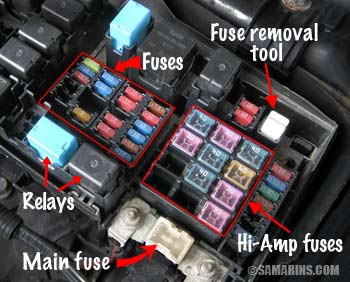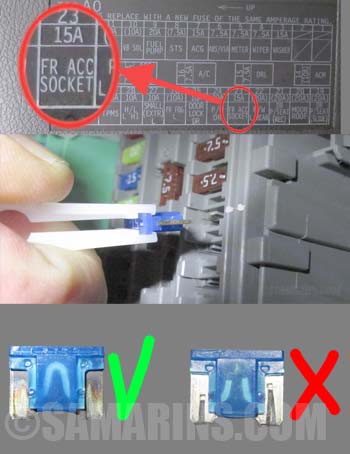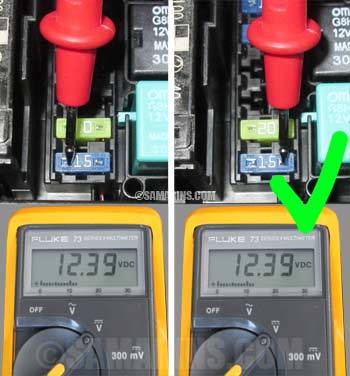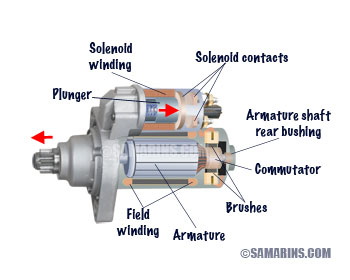How to Check a Fuse in a Car
Updated: August 14, 2021
Fuses are safety devices that protect electric circuits in a car from excessive current (overloading). Without a fuse an overloaded wire could melt or catch fire. Each circuit is protected by its own fuse. Several larger fuses with high Amp rating protect multiple or high-current circuits, such as electric power steering or radiator fan circuits.
There is also at least one main fuse. The fuse removal tool is also typically located in the fuse box or in the fuse box cover.When any electrical component in a car doesn't work, the first step is to check the fuse that protects the circuit with this component. Modern cars typically have two fuse boxes: one under the hood, and the other inside the cabin. You can find the fuse map in the owner's manual, or on the fuse box cover. There are several ways to check fuses. The easiest way is to pull the fuse out and check it visually; you can find the directions in the vehicle's owner's manual.
How to check the fuse visually
For example, in this car, the cigarette lighter socket, also known as the front accessory power socket, stopped working. We are going to check the fuse. In this car, the inside fuse panel is installed right above the driver's kick panel. We found a tool to pull fuses inside the fuse box in the engine compartment.Turn the key to the OFF position. Before pulling the fuse, It's always a good idea to mark its position, so you can install it into the same spot. We take the tool and pull the fuse with it. As you can see, the fuse is blown (on the right). Fuses have a thin metal conductor inside that melts when the current is higher than the fuse rating. In this blown fuse the conductor is melted.
If a fuse is blown, something has shorted the protected circuit. If the problem is not fixed, the fuse will blow again. In this car, it was a small screw that fell into the front cigarette lighter socket. Spare fuses in this car are also located inside the fuse box cover in the fuse box under the hood.
How to check the main fuse
 This main fuse is OK. See also: Main fuses located at the battery positive terminal.
This main fuse is OK. See also: Main fuses located at the battery positive terminal.How to check a fuse with a multimeter
If you have a multimeter, there are two ways to check a fuse. The first way is to measure the voltage at both pins (blades) of the fuse. Small fuses in the car have the top portion of both pins protruding through the top of the fuse, see the photo. This allows measuring the voltage at each side of the fuse without pulling it out.Set the multimeter to DC (Direct Current). Connect the COM (black) terminal to the negative battery terminal or a metal part that is connected to the vehicle chassis or body. Set the parking brake and turn the ignition to the ON position. The ignition needs to be ON, because with ignition OFF, not all fuses are powered. With the positive probe, check the voltage at both sides of each fuse. A fuse is just an electrical conductor. If both sides show 12 Volts, the fuse is good.
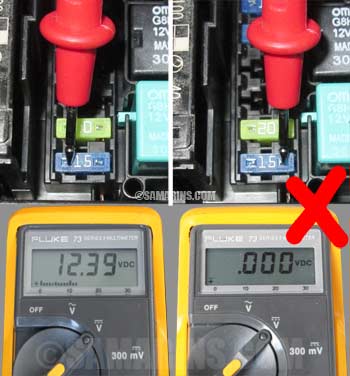 If there is 12 Volt on one side of the fuse, but there is no voltage at the other side, the fuse is blown.
If there is 12 Volt on one side of the fuse, but there is no voltage at the other side, the fuse is blown.How to check fuse resistance with a multimeter
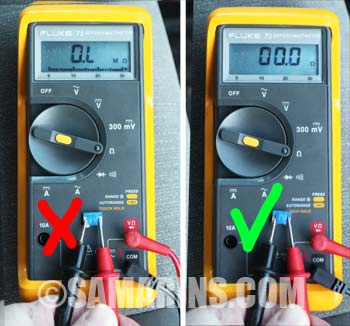 In the left photo, the fuse is blown, the multimeter shows OL, which means no continuity or the resistance is higher than can be measured. In the right photo, the fuse is OK, so the multimeter shows 0 Ω or Ohm. Click on the image for a larger view.
In the left photo, the fuse is blown, the multimeter shows OL, which means no continuity or the resistance is higher than can be measured. In the right photo, the fuse is OK, so the multimeter shows 0 Ω or Ohm. Click on the image for a larger view.To measure resistance of any electric component, it has to be disconnected from the electric circuit. You can't measure electrical resistance while the component is plugged in or powered. Switch the multimeter to Ohms and connect the probes as in the photo.
What can cause a fuse to blow?
A fuse protects the circuit from higher current than the circuit can handle. If a fuse is blown, it means there is a short cirquit somewhere, whether between two wires or the power wire and the ground (car body).Advertisement
1. The most common case is when a metal object (e.g. coin) falls inside or a shorted accessory is plugged into the front accessory power socket (cigarette lighter socket).
2. The wire harness that goes into the trunk lid or liftgate breaks in the place where it bends, shorts and pops the fuse related to taillights or brake lights.
3. The wrong bulb installed in one of the headlights or taillights can also pop the fuse.
4. The damaged or rubbed through trailer harness shorts out.
5. A wiring harness that is connected to some component inside the engine bay rubs through and shorts the fuse. In some older Mercedes-Benz cars, for example, it was a fairly common problem when the insulation on the engine wiring harness cracks shorting the wires and popping the fuses.
